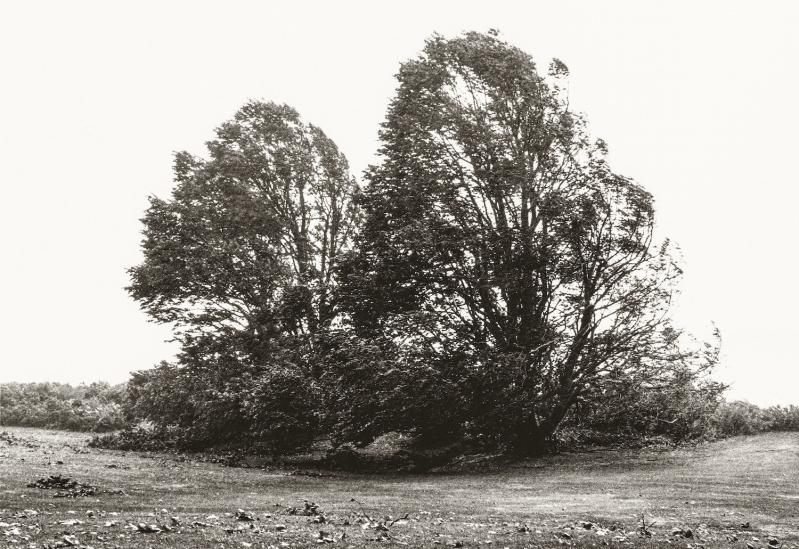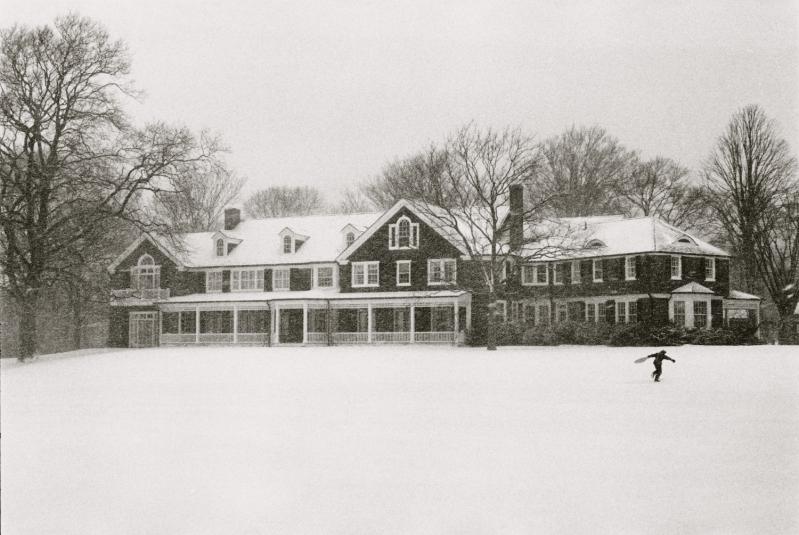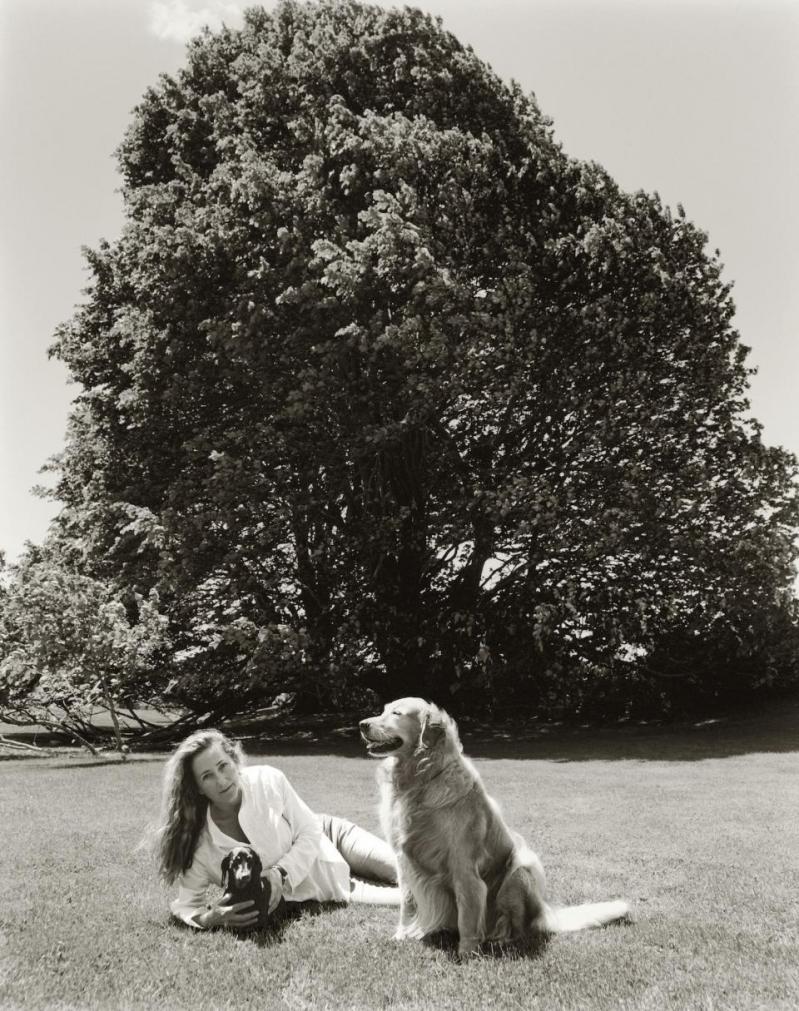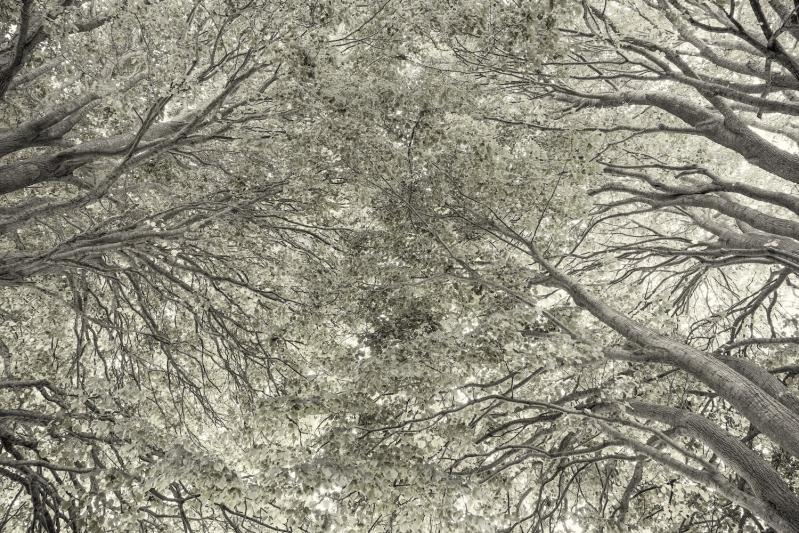At the beginning of her career in the mid-1970s, Priscilla Rattazzi got valuable advice from her employer at her first job. She was working as an assistant to the famed fashion and portrait photographer Yasuhiro Wakabayashi, better known as Hiro.
In her memory, she was Hiro’s lowest-level employee. Hiro, who would become a lifelong mentor, must have seen something promising in her, because every now and again he would invite her to stay late at the studio to eat sushi and discuss life and work.
“He would tell me over and over again, ‘Remember, Priscilla, work will always be there for you,’ ” she recalled at a talk for The Society of the Four Arts in Palm Beach recently.
“Work,” Hiro told her, “will never let you down, work will never betray you, especially in times of personal crisis.”
Not long afterward Rattazzi broke away on her own, making her mark as a successful fashion and portrait photographer, before turning her lens to people and places she cherishes, Georgica Pond in East Hampton among them, for a series of books. But she never forgot Hiro’s advice. It would be prophetic.
For the past three years, Rattazzi has endured a cascading personal crisis. So, she turned to work.
The result is a book, Three Lindens. Its thirteen photographs and two brief essays — evoking a remarkable combination of tender, turbulent, heartbreaking, and heroic — are her farewell to an East Hampton life and property she loved, and to three huge, majestic, and, as she would discover, ancient “champion” linden trees that stood watch over it all.

Until 2021, Rattazzi and her family owned and lived in one of the most breathtaking properties on the South Fork, Briar Patch on Georgica Pond. The term estate gets thrown around so much out here it has lost the majesty of its meaning, attached to charmless spec houses undeserving of the grand designation. Briar Patch isn’t one of those.
Its 11-acre storybook setting at the heart of the Briar Patch Historic District (on the National Register of Historic Places) is a step back in time. It commands something close to a quarter-mile of Georgica Pond’s eastern shoreline. The view from the wide Southern-style porch on the south side of the 10,000-square-foot Georgian Revival house stretches south across a vast lawn, over the pond, to the ocean in the distance.
In the middle of this picture are the three 200-year-old lindens. Visually, but also in a way that can be felt only by being in their presence, they dominate the vast property. It belongs to them.
The house was built in 1931 as a summer retreat for its original owners, a New York physician, Dr. Shepard Krech, and his wife, who were active members of what was then called the East Hampton summer colony. The property includes a second house for guests, a pool house, acres of woods, and a small pond.
Briar Patch has had only three owners. For its third, the family of Rattazzi and her husband, Chris Whittle, it was love at first sight.
Flush from Chris Whittle’s successful sale of half his company to Time Inc., the couple bought the property within 48 hours of seeing it in 1989. Realtor friends said they overpaid, at $7.3 million. They didn’t care. They could, and they were swept away by it.
Briar Patch bound the family together. The two youngest children were born a few years after their parents moved in and all three children grew up at Briar Patch in the summer and on weekends.
The family became a familiar presence on Georgica Pond and at the beach, which they would reach by small sailboat or kayak. That often-deserted strip of sand, separating the tidal lagoon and the Atlantic, felt like their own private isthmus.
Friendships flourished with neighbors and people who frequented the pond. Summers were idyllic. Rattazzi, who already had published two Rizzoli photography books, created two more with the publishing house Callaway that focused on nature and life around Georgica Pond, including one titled simply Georgica Pond.
Town & Country magazine described all this in 2006 with the headline Priscilla’s World.
“All is right with the world,” Pamela Fiori, the magazine’s editor in chief commented in the piece. “At least the world on Georgica Pond.”

But, as the years wore on, it became clear that Briar Patch would not be forever, Rattazzi reflected recently. The three children, grown now, began to spend less and less time at home. The house, which always felt big, began to feel impossibly enormous. Maintenance on the estate was expensive and endless.
“I knew Briar Patch was not the right place to grow old, I knew the time was up, I’d known it for some time,” she told me this spring.
She makes it sound like all these events went down like a well-laid plan, but there were other — harsher — forces at play.
In her essay for the book she delicately navigates around the darkness that enveloped the final years at Briar Patch. She gracefully hints only at “turmoil” and “uncertainty” and that “something had gone astray.”
When the end eventually came, it was brutal.
For much of their three decades at Briar Patch, Whittle had been on a wild roller-coaster ride with his media and education businesses. It was a ride that brought soaring highs and crushing lows, all of which were covered extensively in countless articles and at least two books. He was cited as owning and running one of the “top 100” media companies in America in the 1990s . . . and was taken down in 1994 in a New Yorker story titled The Grand Illusion. He was called a visionary pioneer in charter-school and private education, but in recent years investors turned away — some turning against him — as his projects lost money and a flagship school closed.
To fund some of his ventures he borrowed extensively against the house. Eventually, debt that he and his businesses could not repay brought the end to their life there. Figures vary widely, with The Wall Street Journal reporting debt of at least $13 million (although the exact figures, which are difficult to obtain, are likely far, far higher; the real estate website behindthehedges.com recently reported more than $80 million in debt against the property). By 2019, creditors were closing in.
Rattazzi watched all this unfold in anguish. She did what she could to advise and support her husband, but she was powerless to change the course of things.
“Surfing ahead of a tsunami,” she wrote on a Post-it note, and posted it on her bathroom mirror, where it stayed for almost a decade before the financial tsunami actually hit.
Never before had Hiro’s advice about the importance of work in a moment of crisis been more true. Even as her personal world was unraveling, and the ground felt as if it were crumbling beneath her feet, Rattazzi worked her way to a new summit of her professional life.
Outraged by President Trump’s decision in 2017 to cut in half the 1.88 million-acre Grand Staircase-Escalante National Monument in southern Utah, she set about photographing the fragile and ancient mushroom-capped rock sculptures in the region. The resulting collection, Hoodooland (named for the hoodoos, or tent rocks, found in the park), formed the basis of an exhibit in Manhattan that garnered gushing coverage on the front page of the Arts section of The New York Times in the fall of 2020.
“Hoodooland was definitely a healing journey,” she told an audience recently. “The void I had felt around me for years had been replaced by my work.”
“It was exhilarating,” she said of the praise in The Times.
But that high was short-lived. The end at Briar Patch came only half a year after the Hoodooland exhibition closed. The couple officially lost the property in a court-ordered auction in July of 2021. Once listed for $140 million, it was transferred to Whittle’s former company for $700,000.
The family was allowed to remain in the house until late 2021, thanks to the state ban on evictions during the Covid pandemic.
Strains in the couple’s 30-year marriage had also reached a breaking point, Rattazzi explained. They were divorced last year.
In the meantime, the grand house sits locked up as of this writing in late spring, devoid of furnishings and of life, dust collecting on its two-foot-wide reclaimed floorboards, its handmade wallpaper, its hand-stenciled ceilings. The property itself shows some signs of its many months of desertion. The lawn is shaggy, leaves are piled up in nooks and corners, and moss has built up on roofing shingles.
“A place so loved did not deserve such an ignominious ending,” Rattazzi reflected, then, a moment later added a word about going it alone: “And I needed to live my life on my own terms.”
In May of 2022, four months after leaving Briar Patch, Rattazzi ran into the architect and art collector Peter Marino, an old friend, at a wedding in Florida. She fell into his arms, crying. Marino had known her and her extended family — the Agnellis, who built the Fiat corporation of Italy, where she grew up — since she was a teenager. He’d done some work for the Agnellis and had become a collector of Rattazzi’s Hoodoo portraits. In fact, their connection went even deeper: He had introduced Priscilla to Chris in 1988 and had been the architect when the newlyweds undertook the renovation of Briar Patch the following year.
“If anyone understood what I was going through it was Peter,” she said.
“It was a moment of extreme fragility,” Marino recalled. “There were tears.”
They talked briefly, and when he asked her about recent work, she described the lindens, and how she missed them. She had photographed them in all seasons and all sorts of weather, for years. She had taken a whole series her final summer at the property. “I told Peter that I had gotten through by photographing the trees. It was my ritual.”
Marino responded by proposing that his art foundation publish a book of the photographs and hold an exhibition.
“He said he wanted to make it an homage to the property, I couldn’t believe it. It was precisely how I wanted to tell this story about this moment,” she said.
In a way, with Marino’s help, life had made a full, perfect circle. The book will be released this summer at a July opening at the Peter Marino Art Foundation in Southampton.
The 13 photographs in Three Lindens express it all: the soft-focus leaves of loneliness, the shimmering blooms of joy and beauty, the fierce black-and-white limbs of turmoil, even perhaps rage. The trees — dressed in snow, stoically enduring hurricanes (Bob and Irene), in glorious flower, in love.

Rattazzi had been drawn at first by the lindens’ beauty, their strength, the calm that descended on her when she was with them, watching the leaves turn in the breeze or the bees descend on the fragrant blossoms, the reassurance she felt from their guiding presence as she paddled home over the pond. As they grew to know each other, she learned more about their less-obvious virtues and her devotion grew. Cultures around the world consider lindens sacred, beneficent protectors; they are trees of maternal love, of healing, of justice, of harmony. From them come oils, elixirs, and medicines to heal the skin, the organs, even the mind. And they can outlive us over and over again, some nearly to 1,000 years.
The three at Briar Patch began their lives around 1800 when their ground along Georgica Pond was a mixture of woodlands and the western limit of farmland still tended then by descendants of European settlers. The largest of the three trees, all of them tilia americana, the American species of linden native to eastern North America, is 70 feet tall. Its trunk is the size of a small car, 24 feet in circumference. After being inspected and measured by Tucker Marder, an artist and arborist from Springs, it was declared a state “champion,” the largest linden in New York State, in 2022.
With a touch of admiration, Rattazzi writes in the book how, during her final months at Briar Patch, she pointed her lens upward into the trees’ long, bowed limbs, and “noticed, perhaps for the first time, how their branches were intertwined, embracing each other like a family . . . ”
The final time she drove away, she thought to herself, “I hoped I would be as resilient as they are.”
It has been a year and a half. She still visits in her dreams, she says. And, in her nightmares, where in one vision strange men in dark suits were there, driving her away.
“I am suffering so much at the thought of the house on life support (with no fresh air),” she wrote in an email in April. “And I want the trees to be loved again, because they must be so lonely without us, without me.”
The Peter Marino Art Foundation is housed in the former Rogers Memorial Library building in Southampton Village, which Marino bought in 2018. He spent three years restoring the facade and redesigning the interior to create an exhibition space, largely for his own immense and astonishing collection of art assembled over 40 years and spanning thousands of years, from Old Master paintings to Egyptian, Greek, and Roman antiquities, from Renaissance and Baroque Bronzes to 20th-century photography, French ceramics, and rare books. It is open to the public, by appointment.
A “Frick by the sea” is how Marino himself has described it. The foundation also publishes art books.
His first thought at seeing Rattazzi’s linden photographs was concern for their fate. Would new owners cut them down? A passionate gardener and landscape designer — whose Southampton property itself is the subject of a Rizzoli book — he remarked: “Maybe this will (the book and the photographs) prevent the cutting of the trees!”
In a moment of brutal honesty, I raised a pointed but necessary question. “Some might read this and say, ‘Cry me a river,’ ” I said, as gently as I could. It needed to be said, as a reminder, a reality check.
“Yes, I get it,” she replied.
The child of a powerful and wealthy Italian family — her mother was Italy’s first female foreign minister — she is honest about and grateful for her good fortune. She has the strength and confidence of someone with great talent and many friends. She has more than adequate financial resources, still, and photography projects and speaking engagements. She has moved to a small house in southern Florida. Life is fine.
“I photographed the trees in every kind of storm, including my own, so the book is a journey from real storms to metaphoric ones. The property deserved another story. I also just wanted to focus on how lucky I was to live there for 30 years.”
There is sweetness in the memories of the Briar Patch years and the marriage. She acknowledges Chris Whittle warmly in the book.
“Look, here I am, living in a small house in Palm Beach. I’m okay,” she said. “I’m not looking for sympathy.”
More than anything, she says, Three Lindens and everything that went into it was a way to reclaim the Briar Patch story, and make it hers.
“I photographed the trees in every kind of storm, including my own, so the book is a journey from real storms to metaphoric ones,” she said. “The property deserved another story. I also just wanted to focus on how lucky I was to live there for 30 years.”
In late April, with permission from the company that now controls the property, she returned to Briar Patch with her daughter. It was dusk, a crimson sunset over the western horizon. She embraced the trees and burnt some sage. The smoke swept up into the wind.
“I pray that you will be loved,” she said to the lindens, before turning and driving away in the falling light.
Priscilla Rattazzi will give an artist’s talk and sign copies of Three Lindens on July 29 at the Peter Marino Art Foundation on Job’s Lane in Southampton, starting at 11 a.m. Details at petermarinoartfoundation.org. The book is also being sold at the foundation, as well as at the Monogram Shop on Newtown Lane in East Hampton and the Marders garden shop on Snake Hollow Road, Bridgehampton.


